#Heartland campaign
Text
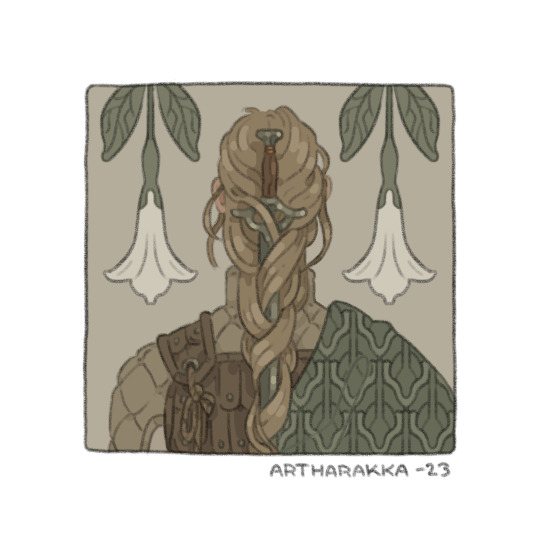
🦋 V Spymaster 🥀
#swordtember#swordtember2023#as said a little simpler! at least colour scheme#and little smaller canvas to keep me sane and my wrist working#very vague but it is @artist-rat's character#c: Sascha#Heartland campaign#dnd#ttrpg#story: Heartland
3K notes
·
View notes
Text
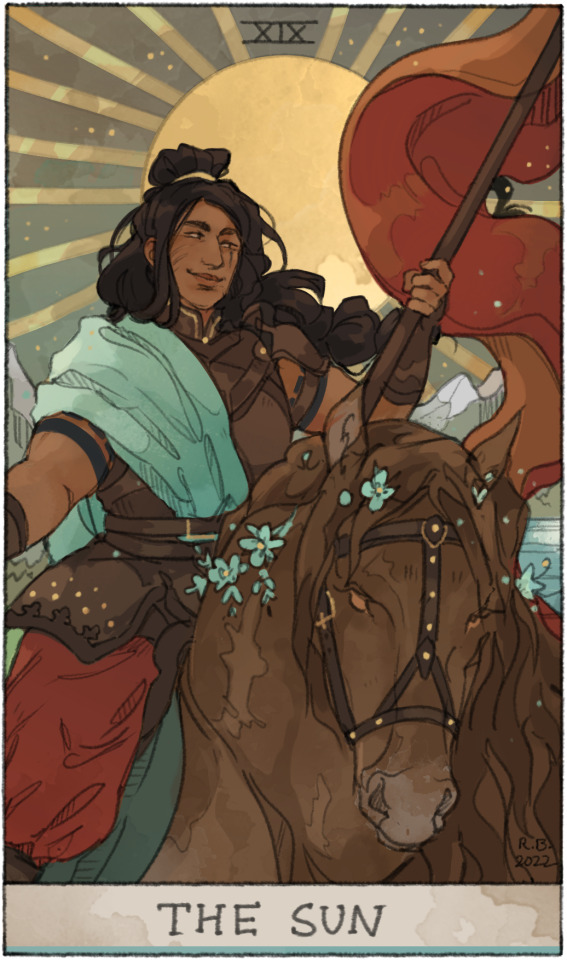
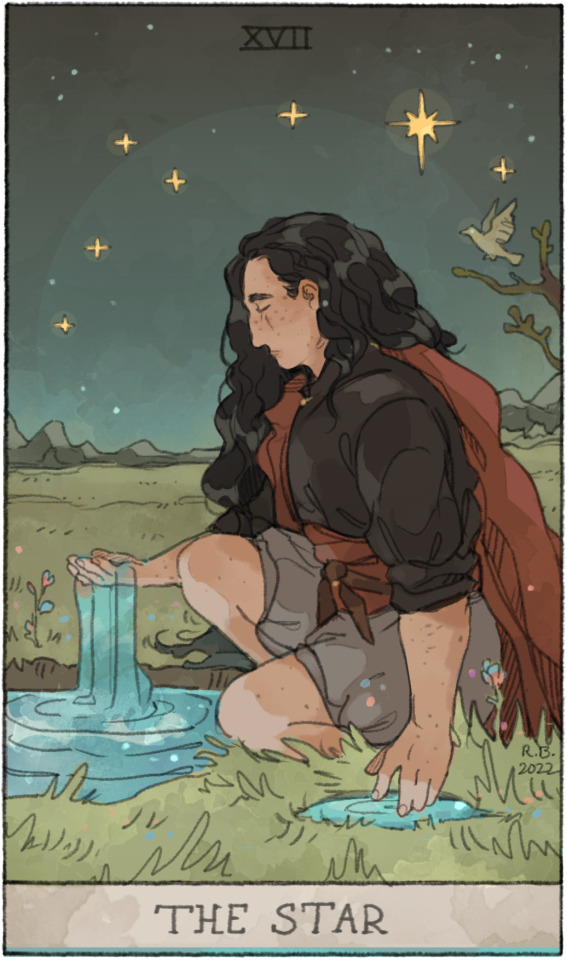
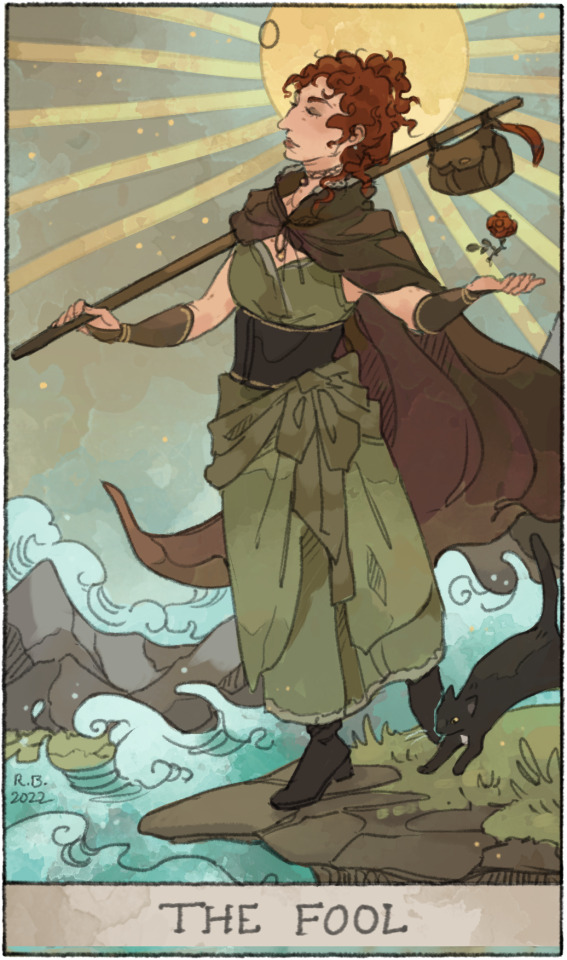


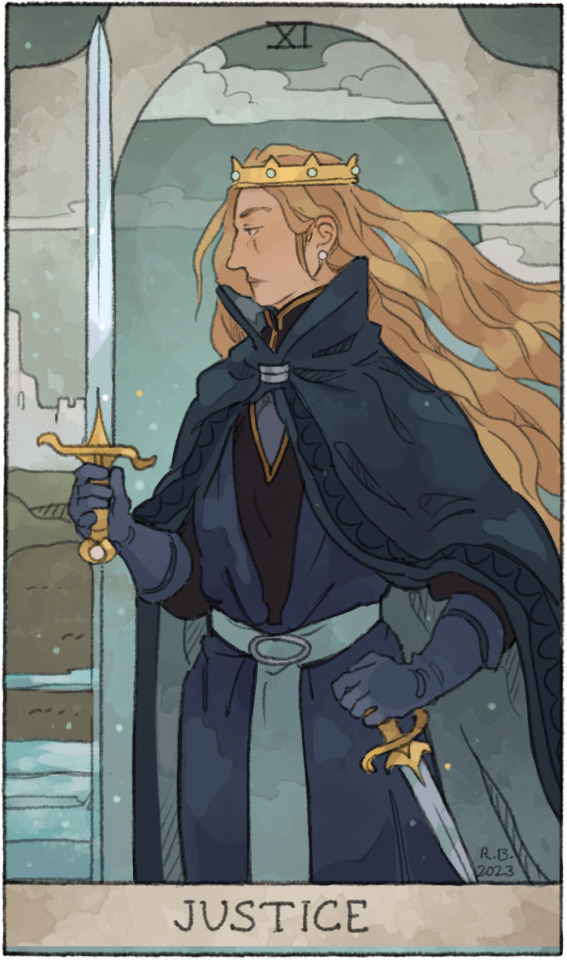
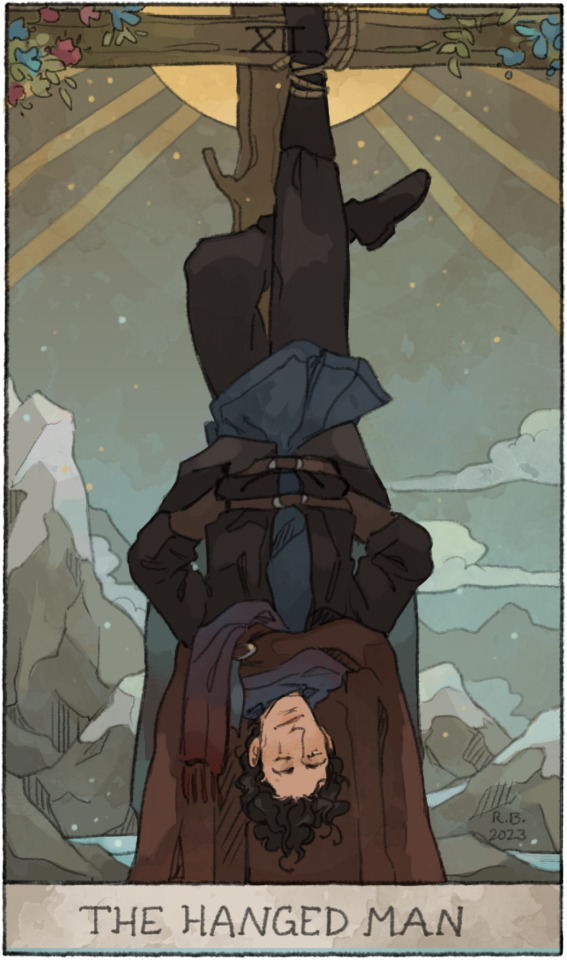
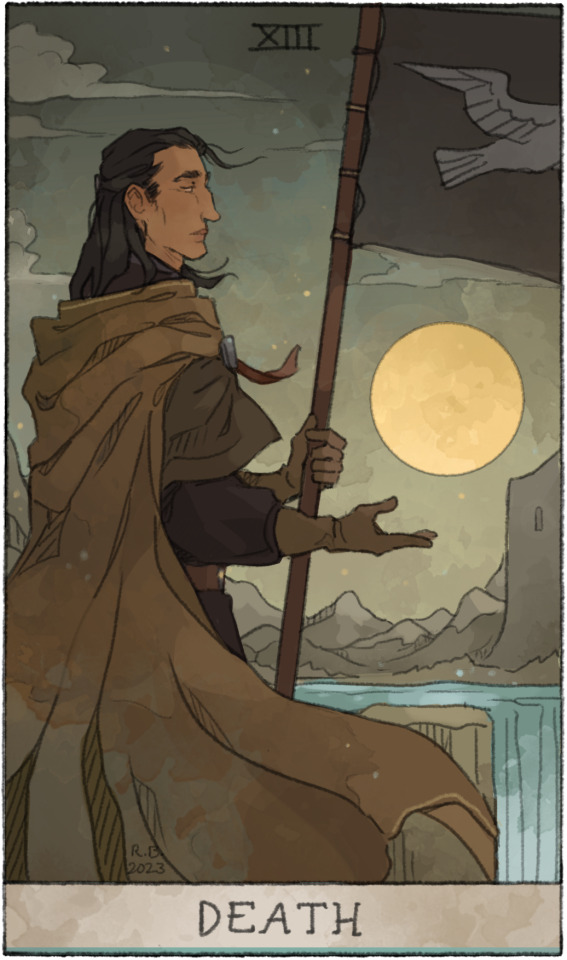
all tarots i've done of my homebrew d&d campaign Heartland (so far & for now)! featuring the player characters Vernonia and Rhiam + current major companion npcs
#d&d#dnd#d&d campaign: heartland#oc: vernonia @iijadraws#oc: rhiam @artharakka#oc: althea#oc: cian#oc: trindel#oc: lorelei#oc: maerd#oc: athe
453 notes
·
View notes
Text
the problem with explaining the infrastructure of the town in college AU and also the social landscape and also mild-to-moderate events and happenings is that it's immediately going to become apparent that we really just jammed whatever and whoever we wanted in there and it got instantly out of hand and now it's just a core tenet of the universe. i never even talked about Fleur de Lis on here.

he's bearing witness to the most insane conservative infighting and billionare's out of touch posts he's ever seen in his life

also it was created by Lysandre. From Pokemon. :]
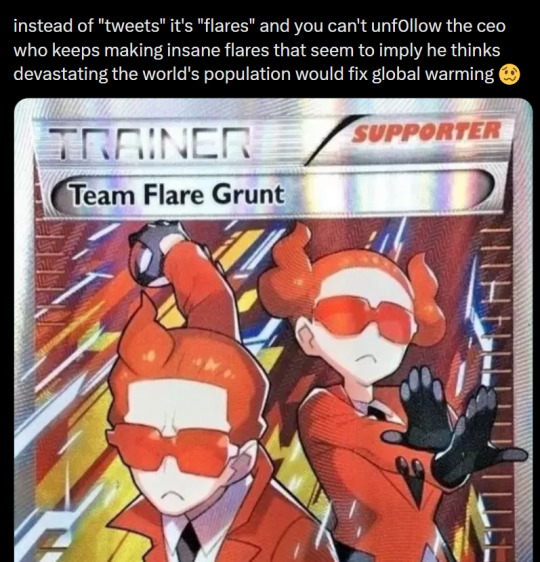
#and now Fleur di Lis is just like. an existing prominent website in this universe that we bring up sometimes#theres so many secret pokemon characters hanging out in this world. dont worry about it#anyway mister heartland was having an insane meltdown on this website post losing his reelection campaign#ygo posting#ygo spinoff college au
16 notes
·
View notes
Text
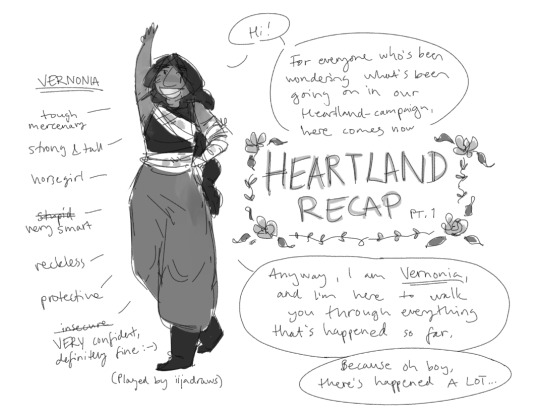

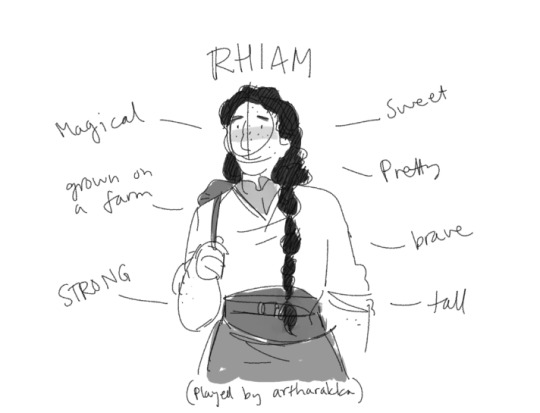




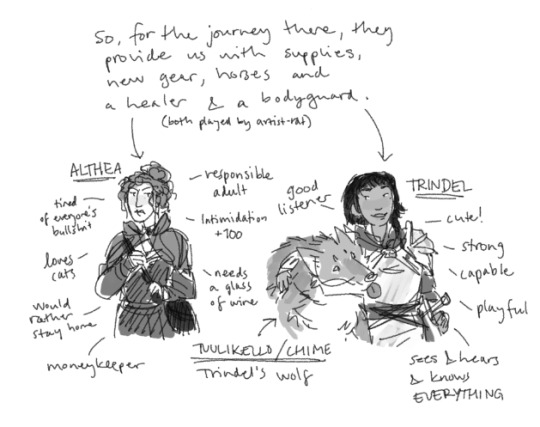
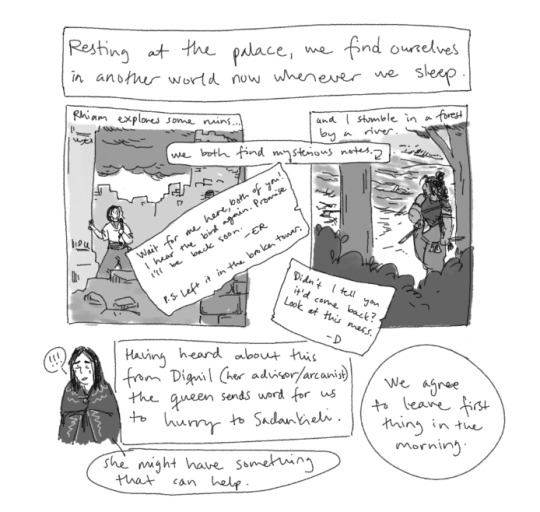
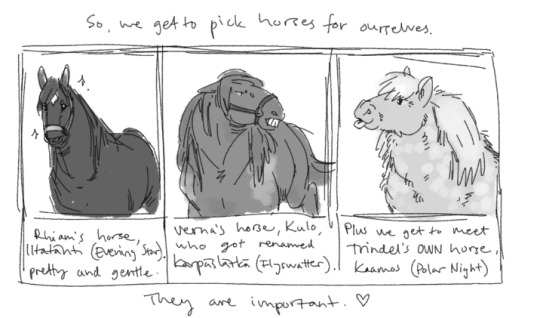
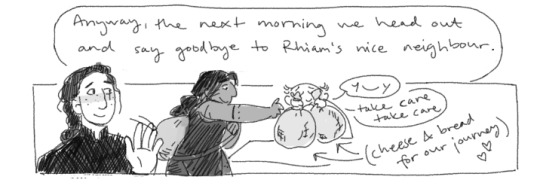



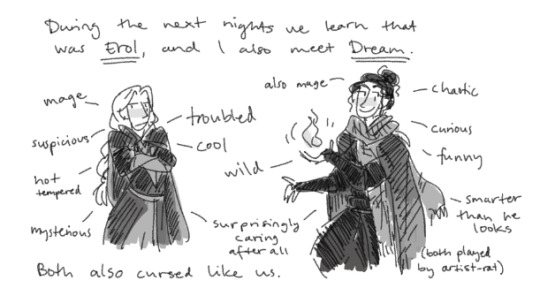
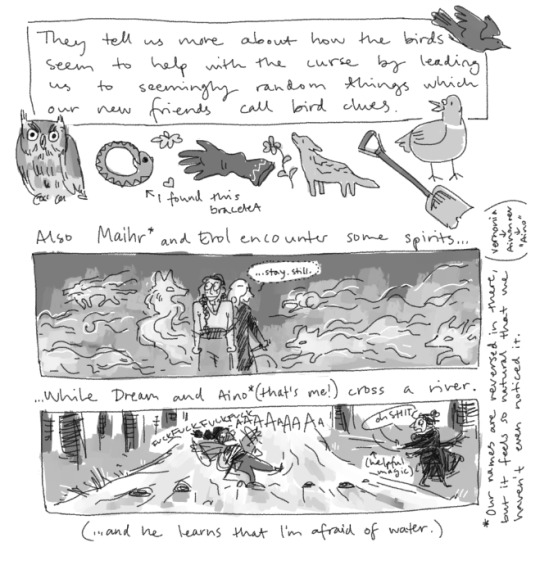

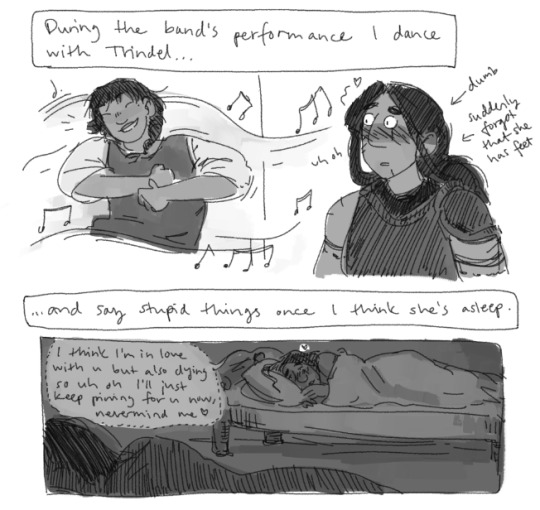


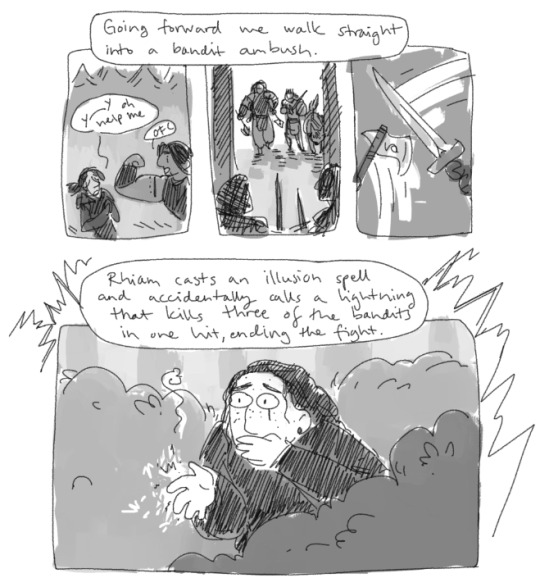

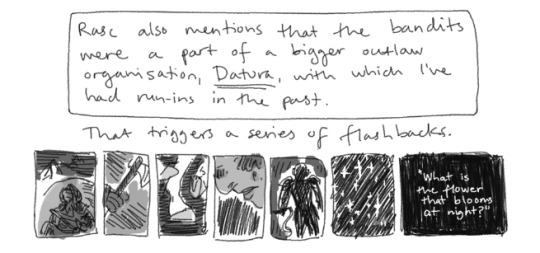

So, yeah!
We're much further in the campaign at the moment, but this is where the first "chapter" of our adventure ended. The second chapter's recap will be up as soon as I get it done!! We've now just started playing the third chapter and oh boy it's so good already ,_____,
Anyway a HUGE shout-out to @artist-rat for nourishing us (me and @artharakka) by creating & dming this campaign for us!! <3 I'm living and can't wait to continue again!!!! ;w; <3
Also another HUGE shout-out to both of you for creating so much good art for nourishment in between the sessions ;--;; <3 Here are some pieces for y'all to check out: [x] [x] [x] [x] [x] [x] (There's more out there, just check out their Heartland tags if you want to see more!)
The story & the world are for a big part based on the first fantasy world we made together with Rat in like 2010, but they've now revised it and made a lot of amazing changes to it so it's all new to me now too, with still the nostalgy for our old characters and getting to know them all anew <3
#heartland recap#d&d heartland#dnd#campaign: heartland#aaaaaaaaaaaa so yea these are the blorbos that inhabit my heart and mind now#i love them all so much#and the whole story oh my gosh#i am GLAD this is a LONG campaign bc as much as i want to see and experience everything i also don't want it to ever end dhfdhfdhdgdhf
27 notes
·
View notes
Text

not posting this on my art blog bc its a bs doodle but. I love doodling bullshit during games. Here’s some Frankie-Martin <3
#heartlands posting#ttrpg posting#new tags for posting about my campaigns#I should do a lore dump post ….
0 notes
Text
updated! ID by @swosheep
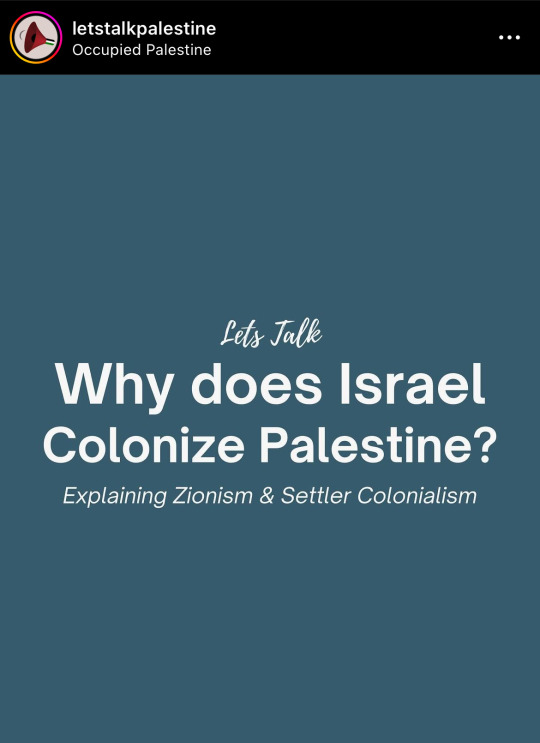
ID 1: all images are screenshots of an Instagram post by letstalkpalestine. The first is a title slide and reads "lets talk: Why does israel colonize Palestine? Explaining Zionism and Settler Colonialism".
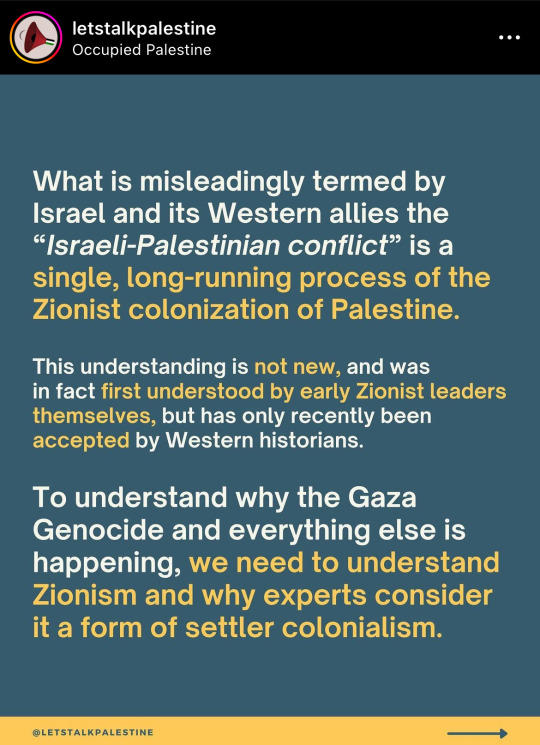
ID 2: the second image reads: "What is misleadingly termed by israel and its Western allies the "israeli-Palestinian conflict" is a single, long-running process of the Zionist colonization of Palestine. This understanding is not new, and was in fact first understood by early Zionist leaders themselves, but has only recently been accepted by Western historians. To understand why the Gaza Genocide and everything else is happening, we need to understand Zionism and why experts consider it a form of settler colonialism."
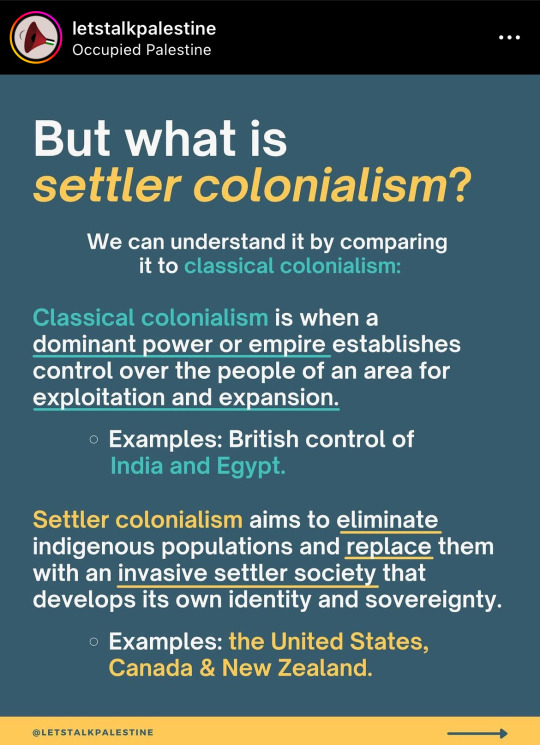
ID 3: the third image is titled: "But what is settler colonialism?" The body text reads: "We can understand it by comparing it to classical colonialism: Classical colonialism is when a dominant power or empire establishes control over the people of an area for exploitation and expansion. Examples: British control of India and Egypt. Settler colonialism aims to eliminate indigenous populations and replace them with an invasive settler society that develops its own identity and sovereignty. Examples: the United States, Canada & New Zealand."

ID 4: the fourth image is titled: "Settler colonialism is different from classical colonialism in 3 main ways:". There is a table comparing the ways. One column of the table is titled: "Settler colonialism" and the 3 points are: "1. Only temporarily & initially relies on the empire for support. 2. Motivated by desire to take over land. 3. Treats new land as a permanent national homeland for settlers." The second column of the table is titled: "Classical colonialism" and the 3 points are: "1. Always dependent on mother empire. 2. Motivated by exploiting natural resources. 3. Uses new land and its resources to serve the empire."
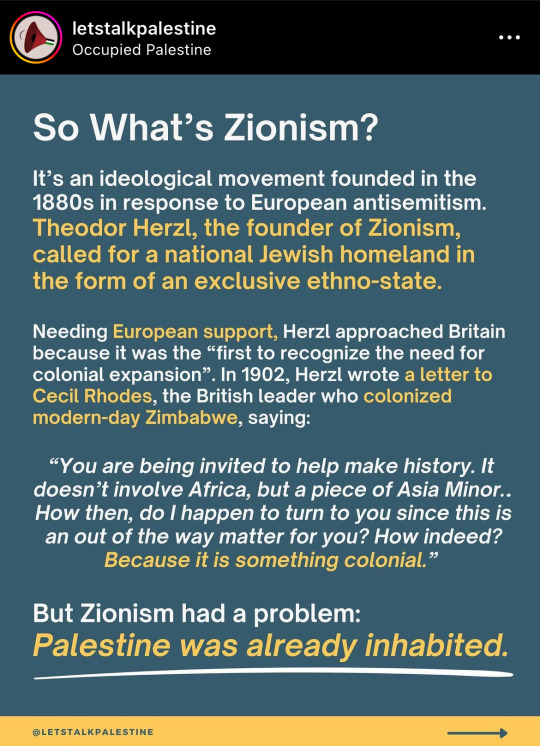
ID 5: the fifth image is titled: "So What's Zionism?". The body text reads: "It's an ideological movement founded in the 1880s in response to European antisemitism. Theodor Herzl, the founder of Zionism, called for a national Jewish homeland in the form of an exclusive ethno-state. Needing European support, Herzl approached Britain because it was the "first to recognize the need for colonial expansion". In 1902, Herzl wrote a letter to Cecil Rhodes, the British leader who colonized modern-day Zimbabwe, saying: 'You are being invited to help make history. It doesn't involve Africa, but a piece of Asia Minor.. How then, do I happen to turn to you since this is an out of the way matter for you? How indeed? Because it is something colonial.' But Zionism had a problem: Palestine was already inhabited."

ID 6: The sixth image is titled: "Zionism & Palestinians". The body text reads: "To establish a Jewish state (israel) in Palestine, Jewish people had to constitute the majority of the population. [quote] 'Only a state with at least 80% Jews is a viable and stable state.' [unquote] -[a quote from] Ben-Gurion, Israel's first Prime Minister. But Palestinians were the majority at the time. For Zionism to succeed, non-Jewish people had to be removed from Palestine and, in turn, Jewish settlers had to take their place. [quote] 'We must expel the Arabs and take their place' [unquote] -[a quote from] Ben-Gurion, Israel's first Prime Minister. This was implemented, and in 1947-1949, Zionist militias conducted a mass campaign of ethnic cleansing against Palestinians - the Nakba. 80% of Palestinians in the heartland were expelled to create Israel's Jewish majority."
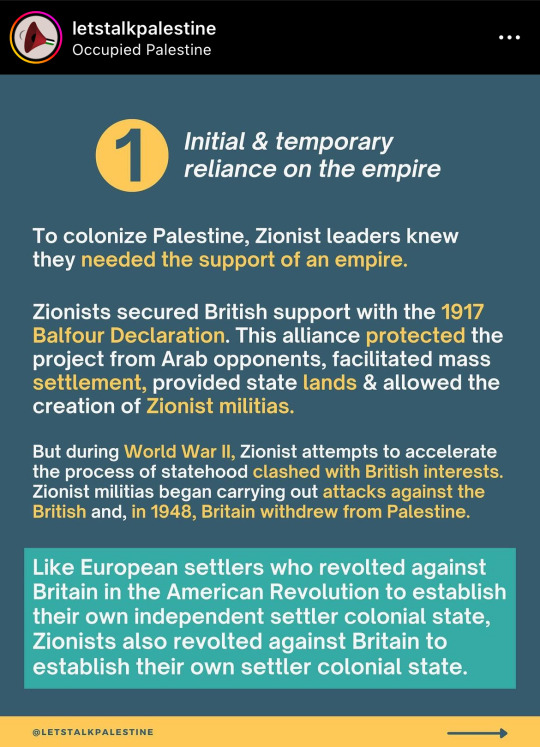
ID 7: The seventh image is titled: "1. Initial & temporary reliance on the empire". The body text reads: "To colonize Palestine, Zionist leaders knew they needed the support of an empire. Zionists secured British support with the 1917 Balfour Declaration. This alliance protected the project from Arab opponents, facilitated mass settlement, provided state lands & allowed the creation of Zionist militias. But during World War II, Zionist attempts to accelerate the process of statehood clashed with British interests. Zionist militias began carrying out attacks against the British and, in 1948, Britain withdrew from Palestine. Like European settlers who revolted against Britain in the American Revolution to establish their own independent settler colonial state, Zionists also revolted against Britain to establish their own settler colonial state."
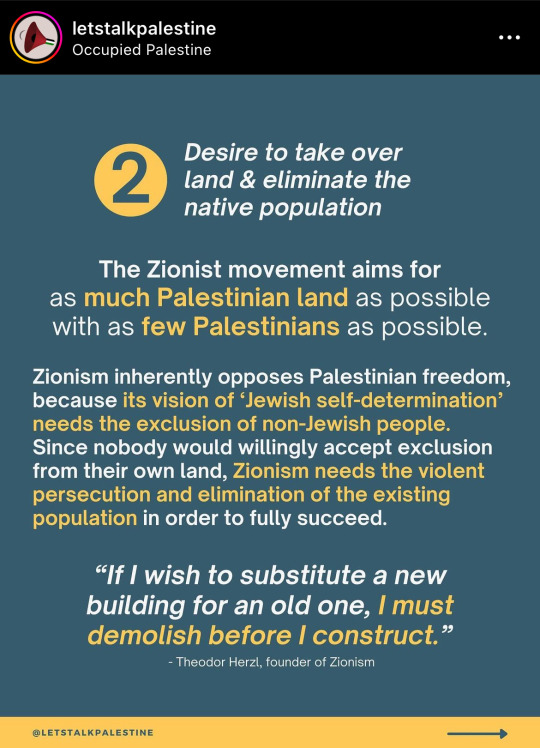
ID 8: The eighth image is titled: "2. Desire to take over land & eliminate the native population". The body text reads: "The Zionist movement aims for as much Palestinian land as possible with as few Palestinians as possible. Zionism inherently opposes Palestinian freedom, because its vision of 'Jewish self-determination' needs the exclusion of non-Jewish people. Since nobody would willingly accept exclusion from their own land, Zionism needs the violent persecution and elimination of the existing population in order to fully succeed. [quote] 'If I wish to substitute a new building for an old one, I must demolish before I construct.' [unquote] - [a quote from] Theodor Herzl, founder of Zionism".

ID 9: The ninth image is titled: "3. Permanent homeland". The body text reads: "Zionism's goal wasn't to establish a temporary base for an empire but a permanent homeland for a new settler population. To create a new society in a populated country, Zionists claimed Palestine by moral & divine right, an example of the 'Logic of Elimination'. A pillar of settler colonialism, the 'Logic of Elimination' is when settlers develop moral justifications to eliminate the native population. Zionist talking points like - 'Palestine doesn't exist'; - 'israel made the desert bloom'; - 'israel is technologically advanced'; are used to justify the elimination of Palestinians. Such points were used in other cases of settler colonialism like South Africa, with the 'Empty Land' myth arguing that Black people arrived in South Africa at the same time as white settlers."

ID 10: The tenth image is titled: "Zionism Today". The body text reads: "A Jewish state was created, but the Zionist project isn't fully realized - Palestinians remain & resist, asserting a threatening national identity. In response, israel has doubled down on its attempts to eliminate the Palestinian people while colonizing more land. Home demolitions, ethnic cleansing, segregated settlements, erasing culture, and apartheid are methods of the Logic of Elimination rooted in Zionism as a settler colonial movement. 'But Zionism is just Jewish self-determination.' All settler colonial movements aim to advance the settlers' 'self-determination' by eliminating the natives. It's never justified. Palestinians are resisting the most aggressive ongoing settler colonial project in the world. Freedom, justice & equality are impossible without dismantling Zionism, a form of: Settler Colonialism."
#reaux speaks#zionism#free palestine#free gaza#gaza#genocide#palestine#settler colonialism#great britain#history#ethnostate#ethnic cleansing#anti zionism#resources#instagram
193 notes
·
View notes
Text
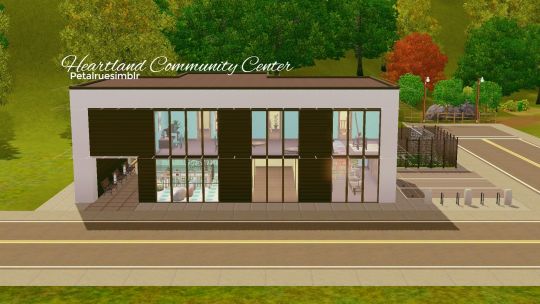
Heartland Community Center
Download Link:
Sim File Share | MTS (for approval)
Description:
HCC is a vibrant hub of activity nestled in the heart of the neighborhood. Sign up for our diverse range of classes and workshops including art, music, writing, sculpting and soccer. We also offer convenient shower facilities, nursery and function room complete with buffet catering options that is perfect for gatherings available for reservations only. Staffed by dedicated volunteers, the HCC is your go-to destination for personal growth and community connection. Join us today!
Details:
Price: 109,851
Lot Size: 30x20
Version: 1.42
Store Content: None
CC Used: 2 (Coffee Machine and the base needed for the Coffee Machine by ATS3) ⚠️Not included in the download
Packs Needed: The Sims 3, Ambitions, Generation, Late Night and Seasons
File Type: Package
This took me a while to finish because I had to make some last-minute changes to a few rooms and remove a few ideas that were already present in other community lots. This is also my first attempt at a modern build, so I kept second-guessing if it looked okay or not and wasn't entirely satisfied with some aspects, which took a longer time to complete.
Click on the Keep Reading below for more information and pictures on this lot.






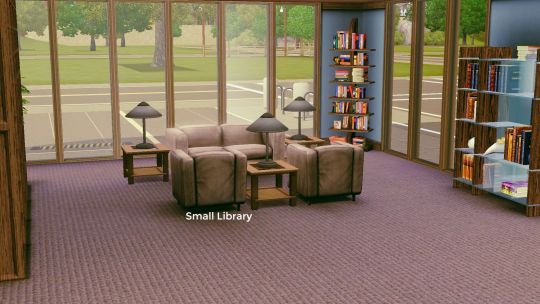
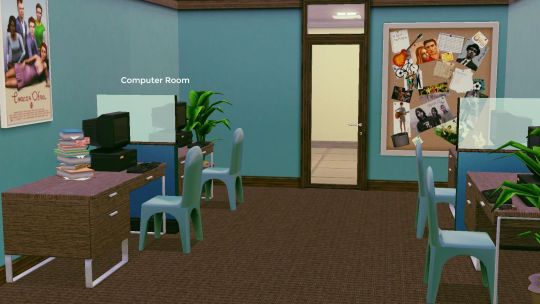
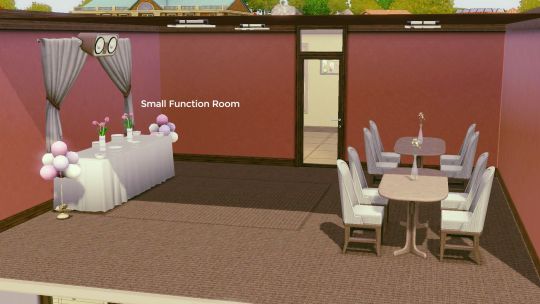
I decided to create a community center that focuses on skill improvement, especially for those sims who may not have the means to acquire the necessary objects for skill-building.
There is an on-site nursery where parents can leave their children, complete with a custom playpen for toddlers to prevent wandering and toys to keep them occupied while also increasing their logic and music skills. Additionally, there's a 'pretend' changing area for toddlers or you can replace the counters with a Dirty No More Changing And Bathing Station from The Sims 3 Store, if preferred.
I placed bookcases containing toddler books in the nursery and skill books in the small library.
There is also a function room with a Buffet Table if ever they get hungry and unfortunately this lot can't be used for destination, birthday or campaign parties due to the lot is set as "Visitors Allowed". However, you can change the lot type if you'd like to host a party here to any of the following lots stated in this Wiki here.
You can also change the Soccer Goal to a Rim Rockin' Basketball Hoop from the The Sims 3 Store if you like that one better, I made sure that their sizes fit in that area.
Outside:
Soccer Goal
Bike racks
Decent parking
Basement:
4 Shower rooms
4 Lockers
4 Toilet Stalls
4 Sinks and counters
8 Mirrors
2 Laundry Basket
Free Towels
1st Floor:
Reception/Waiting area
Nursery: Custom Play Pen, Toys, Custom Changing And Bathing Station, Summer By The Sea Shelf Bookcase, TV
Small Library: The Book Corral and Penningway Bookshelfs, few couches
2nd Floor:
Art Room: 3 Artsy Easels
Sculpting Room: 2 Pedestrian Sculpting Stations
Music Room: Marvin Beats Drum Kit, 4 Sonaflux Guitars, 1 Shibata String Bass, Prudence Pennypincher's Portable Piano
Computer Room: 4 computers
Function Room: 1 Great Eats' Recycled Consumables Buffet Table, Balloons, 8 dining chairs and 2 dining tables, 1 Public Sounds Stereo, Get Up, Get Down Dance Floor
#petalruesimblr#the sims 3#ts3#ts3 simblr#sims 3 download#sims 3 lots#sims 3 screenshots#ts3 download#ts3 screenshots#ts3 simmer#the sims 3 community center#ts3 community center#sims 3#ts3 community#Community Lot
31 notes
·
View notes
Photo

Battle of the Ruhr
The Battle of the Ruhr or the Ruhr Air Offensive (March-July 1943) was a sustained bombing campaign by the British and the United States air forces against the industrial heartland of Germany during the Second World War (1939-45). The offensive included strikes against industrial cities and specific targets such as steelworks, armaments factories, transportation networks, and the Ruhr dams. Great damage was done to Germany's heavy industry, but given that production recovered and even increased, the battle is considered a draw.
Area Bombing of Germany
The Ruhr Valley area was responsible for 60% of Germany's industrial output. The area was such a tempting target it had already been attacked in May 1940, but only by a small force of around 100 bombers, which had not met with any great success. This time it would be different. The commander-in-chief of the Royal Air Force (RAF) Bomber Command was Arthur Harris (1892-1984). He firmly believed that the war could be won by bombing the enemy into submission, that is by smashing war-industry targets and civilian morale. Harris was given support at the highest level to try out the 'bomber's dream' of winning the war by air power alone. To make the dream a reality, Harris had at his disposal such four-engined heavy bombers as the Lancaster bomber, capable of carrying a bomb load of 14,000 lbs (6,350 kg), the Short Stirling, and Handley Page Halifax.
The thousand-bomber raid on Cologne in 1942 had shown what a large attack force could achieve. Such a number of planes, flying to the target in a single formation known as the bomber stream, could overwhelm the enemy defences – anti-aircraft flak guns and fighter planes like the Messerschmitt Bf 109, which patrolled the entire area that had to be crossed to reach the Ruhr. Bombers could not have a fighter escort over Germany at this period in the war given the limited fuel range of planes like the Hawker Hurricane and Supermarine Spitfire, and so the best cover for slow-flying bombers was darkness.
The RAF had tried precision bombing – hitting specific small targets – but these required more dangerous daylight operations (and clear weather), and, given the limited bomb-aiming technology of the time, the results had been very poor, most bombs dropping several miles from the intended target. Such were the difficulties, many planes failed to even find the target. The idea of area bombing (aka carpet bombing) was to have a central aiming point for the first bombers and then successive bombers worked their way outwards, either by intention or accident. Consequently, a large area of the target was more uniformly bombed. The 90-minute area bombing of Cologne destroyed some 15,000 buildings and 1,500 factories. In addition, the city's utility supplies and various transport networks were all severely damaged. There were 469 deaths, 5,000 people were injured, and 45,000 people were made homeless. With 41 aircraft lost, the RAF considered the raid a success. The strategy of area bombing by a large force could now be applied to the Ruhr Valley.
Continue reading...
19 notes
·
View notes
Text
Forgotten [...] is the crystallization during [the early 20th century] of Zionist thinking vis-a-vis the Palestinians, particularly in the person of the paramount leader, David Ben-Gurion [...]. [A]s early as 1936, Ben-Gurion had decided that the only relationship possible with the Palestinians was a "military" one, since they would not accept a Jewish majority nor unrestricted Jewish immigration—this at a time when the Jews constituted not much more than a quarter of the population. [...] Ben-Gurion [...] considered "a Jewish state in part of Palestine as a stage in the longer process towards a Jewish state in all of Palestine." [...] Lecturing to Mapai activists on 29 October 1937, Ben-Gurion explained that the realization of the Jewish state would come in two stages: the first, "the period of building and laying foundations," would last ten to fifteen years and would be but the prelude to the second stage, "the period of expansion."
[I]n the summer of 1937, ten years before the UN partition resolution, Ben-Gurion ordered the Haganah commander of Tel Aviv, Elimelech Slikowitz ("Avnir"), to draw up a plan for the military takeover of the entire country in anticipation of Britain's withdrawal from Palestine expected in the wake of of the Peel Report. [...] Equally illuminating for this period is the persistent preoccupation of the top echelons of Zionist leadership with the modalities of the "transfer" (euphemism for ethnic cleansing of the Palestinian population from any future Jewish state).
As for the immediate antecedents of the partition resolution, they, too, are forgotten. No correlation is attempted between the partition plan and the [...] ruthless campaign of terror against the British (erstwhile architects of the Jewish National Home) by both the Haganah and the so-called "dissident" Irgun (IZL) and Stern (Lehi) organizations carried out between 1945 and 1947. Lehi, of course, had started earlier and had established links with Nazi Germany as of 1940 on the grounds that Britain was the greater enemy, whereas the Irgun (led by Menachem Begin, recently arrived in Palestine from Poland) unleashed operations against the British in Palestine even as British forces under General Montgomery were probing the Western defenses of the Nazi heartland in Central Europe. To be sure, the Haganah under Ben-Gurion tried selectively to keep its distance from the "dissidents," but this did not inhibit it from carefully orchestrated joint operations with them against British "targets" in Palestine in 1946. It was during this period that an innovative array of tactics was first introduced into the Middle East by the Zionist forces, including letter bombs, parcel bombs, vehicular bombs [...], the whipping and lynching of British soldier hostages, booby-trapping their corpses, and electrically detonated mines against civilian targets.
Thanks to these tactics, which culminated in the attack on the Mandatory headquarters at the King David Hotel in Jerusalem on 22 July 1946, in which 41 Arabs, 17 Jews, and 28 Englishmen were blown to smithereens, an all-pervasive atmosphere of terror seized the Palestinian civilian population—a presumably not unintended effect. It was this same atmosphere that propelled the British government, with its garrison of 100,000 crack troops [...] to call it quits, particularly as the other arm of the Zionist grand strategy constituted continuous, cumulative pressure via the new American president, Harry Truman, who had succeeded Franklin D. Roosevelt in April 1945.
The Jewish campaign against the British did not mean that Ben-Gurion considered his relationship with the British to be a "military" one or that he sought an all-out confrontation with them. Quite the contrary, we are assured by Teveth that he saw the relationship as an exclusively "political" one. In other words, all Ben-Gurion wanted from Britain at this stage was to clear out of the way so that he could pursue his "military" relationship with the Palestinians and the Arab countries. And pursue it he did [...] in a massive program of arms acquisition and military buildup [...].
– 1997. Walid Khalidi, “Revisiting the UNGA Partition Resolution,” Journal of Palestine Studies 27.1, pp. 5-21.
25 notes
·
View notes
Text
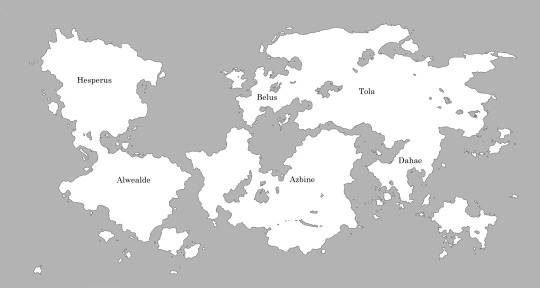
Dev Journal 2: The world of Tellus
This is the current draft version of the world map for my homebrew campaign setting. It was cobbled together using a mix of Fractal Terrains 3, Photoshop, and Wonderdraft.
It's been interesting going through each iteration and trying to land the particular combination of alien and familiar that I want to achieve. If a fantasy world is too Earthlike, it becomes difficult to break away from expectations of what will be found in each area. But if its too alien, the player's expectations of what might be found in a region become harder to visualize. This particular version has not quite accomplished what I'm trying to find yet, future iterations will likely venture more into the alien side of the spectrum. However, this is a good start and while this world is quite familiarly shaped, it'll have some very interesting geopolitics.
As a starter, you may notice that there's not much distance between many of the continents. Seagoing exploration by the Tellus equivalent of the Greeks, Phoenicians, and Polynesians would have likely achieved something equivalent to the Colombian Exchange much earlier than our world. Likewise, trade between the Orient and Occident is much easier, which will create some fascinating opportunities for cultural exchanges. Vast quantities of wealth flow through these vital trade arteries, meaning that any nation with ambitions of being a power worth considering will require a substantial fleet to protect their interests.
Tellus is still embarrassingly underdeveloped so far, with vast amounts of blank space in my documents, but I'll provide a brief description of each continent and its major powers and provide more details later. Names are all provisional and may be changed in future drafts; I like to use placeholders and end up changing them frequently. In the descriptions below I include equivalents to RL nations, this is meant as a reference to their closest geopolitical analogue, not that they are necessarily clones of that state.
Belus: Obviously this world's equivalent to Europe, differentiated largely by the presence of an inland sea. Directly to its north is the Grey Sea, to the south is the Medial Sea. Its greatest power is the Second Empire of Abdera; a sprawling feudal mess equivalent to a super-HRE, stretching from this world's equivalent of Spain to Germany. More often at war with itself than outside powers, the Second Empire's stability and prestige have had an alarming decline due to the emergence of the Republic of Brennos (eqv. Napoleonic France) within its former territories. The Second Empire's neighbors, particularly Dynne (eqv. Great Britain) play a delicate game of exploiting Imperial weakness while trying not to throw the continent into complete chaos.
To the east, the Empire of Melate (eqv. Ottomans) are recovering from a century of decline with a reformist empress on the throne. Their strategic position and the exhaustion of their Belusan rivals fuel the ambitions of elven revanchists.
Azbine: Essentially Africa, Azbine is a huge & diverse continent in terms of politics, climate, geography, and population density. Its northwest coast is largely divided up into feudal possessions of the Second Empire, as well as daughter republics of Brennos legitimized by peace treaty. The northeast corner, south of the large peninsula that is Melate's heartland, are the Majeri Republics (eqv. Venice); an oligarchic federation of city-states that are wealthy and loyal protectorates of Melate. Their cities are among the wealthiest on the planet thanks to the trade routes they sit upon. Along the eastern coastline are small kingdoms and city-states that also thrive on (or prey upon) trade between Azbine and Dahae, as well as Alamgiri colonies (see Dahae below).
Nirimzad (eqv. Congo Free State), the vast territory of a clan of green dragons, encompasses the circular sea in central Azbine and its surrounding coastline. The dragons squabble and intrigue against each other, unified only in extracting as much wealth as possible from their hunting ground. Their warlords and slave armies would likely overrun much of the central continent were they not constantly pitted against each other for the entertainment and petty grudges of the dragons.
Alwealde: South America, duh. The northeast coast is primarily occupied by the Kingdom of Selvas - a secessionist colony from the Second Empire that's also a feudal mess of direct colonial holdings and integrated native vassals. A federation of city-states styled along the lines of the Delian League control the rest of the eastern coast; they are theocratic governments run by a priestly class with rulers descended from a planetouched bloodline.
Hesperus: A handful of Belusan colonies with competing territorial claims squat on the coasts as well as the independent nation of Ladrinne (eqv USA) where the losing Parliamentary faction of the Dynnish civil war fled and established a government in exile. Ladrinne styles itself as the rightful government of the Dynnish islands. The old guard aristocrats are naturally fading away and being replaced by revanchist radicals inspired by the Brenne Revolution. Eastern Hesperus is easily a potential powderkeg for the next war, whether due to colonial competition or Ladrinne's parliament finally deciding to expel the monarchists from 'their' continent. Elsewhere in Hesperus, the natives are doing better than OTL, having never suffered the same population collapse from disease as that which followed contact.
Tola: Obviously an Asiatic continent, Tola's central steppes are the domain of orcish tribes and petty kingdoms (eqv Mongols). To the west, Ryaz principalities and successor kingdoms to an old Orc empire crowd against inland seas and compete for coastal access. To the east are the Golden Lands, the richest agriculture lands in the world thanks to a series of great lakes and high mountain glaciers that feed dozens of rivers. The agricultural wealth of the Golden Lands unfortunately also brings much ambition; the region is divided between six states with a variety of ideologies (eqv. Chinese warlord era)
Dahae: The Dahaen subcontinent is home to what's likely the most powerful empire in the world, Alamgir (eqv. Mughals). Alamgir's orcish ruling class possess sprawling lands teeming with millions, a strong export economy, and a large, well-trained military that is regularly tested in border conflicts with its neighbors. Alamgir shares the subcontinent and its archipelago with several other major powers and dozens of minor states.
11 notes
·
View notes
Note
ohh that is very cool! I get what you mean about Kay, it's just like a person who is able to blend in because there is something unassuming? regular? about him. I am not convinced I am fully conveying that I get what you're trying to say, but I think I understand 😂 as for the names, very cool to read! and I think, especially if you look at all various texts and traditions, it really makes sense to not base yourself around the concept of a 'pure' or 'true' version of characters (it in some ways might even feel as a disservice to what you're drawing from or the intention of the story you're trying to tell). One of the things I remember clearly from when I was studying was something we called the Mabinogion-Frage, in which was questioned whether the Welsh material was earlier than the French (Arthurian) material, and how it interacted. As an extension of this; do you draw from different language traditions as well? I think mostly in context of Arthurian texts, sparked by the spelling variations of Gwaine- e.g. would Walewein, which is a Middle Dutch variant of the name, also work? Thank you so much for answering! ☺️
Yeah exactly!!! Ah this is such a lovely message to read.
So yes for sure I'm drawing for different language traditions! The ones with which I'm most familiar are Welsh, English, Breton and French - so those are my focuses. Obviously I've also been drawing folklore from Scotland, and there's some other literary traditions we'll see later in the show.
Cultural identity of stories does play into Camlann a little bit - for example the Arthur that Gwaine, Perry and Dai know is very much an English Arthur - defined by the propaganda campaign of English imperialism that stole Arthur first in the Elizabethan era, then the Victorian, and lastly moved him to America and Hollywood. The English Arthur is an imperial conqueror rather than the Welsh symbol of resistance he was originally.
In addition to the meta, in the fiction of the story it has relevance too. So Arthur and the Knights moved from Bristol to Glastonury because they realised their story would be stronger in a place that housed their story - and the English Arthur is very much homed in Glastonbury.
Meanwhile, our gang are finding their names slightly more powerful than usual. Peredur is the Welsh variant of Percival, so our Perry is a bit stronger when they're actually in Wales (when it comes to their powers.) Similarly, Morgan's been even more unsettled by her name recently because she's in a heartland of belief for her story (though of course Le Fay would be most powerful in Brittany)
Thank you so much for all your lovely messages! It's so nice to see people engaging with the show <3
11 notes
·
View notes
Text

💙 XI Queen 🕊
#woo another one! only two days late now#swordtember#swordtember 2023#also @artist-rat's character#c: Erol#Heartland campaign#dnd#ttrpg#story: Heartland
700 notes
·
View notes
Text

d&d update: there's girls and they're winning!
#d&d#dnd#ttrpg#d&d campaign: heartland#oc: erol#oc: maihr @artharakka#what if we kissed in a curse realm we’re stuck in😳#what then!!#they had just played truth and dare (essential) and erol was like ough u were taking it so srs and being poetic and shit that was real cool#and i wish we would've goofed around less with dare kissing etc. BTW do you wanna kiss more rightnow
195 notes
·
View notes
Note
I forgot his name his name, but is that little gnc af clown guy from 5ds in your college au? I feel like hes exactly the kind of little freaky guy you enjoy
LAZAR MY FRIEND LAZAR i love that weirdass little clown... he's actually deeply embroiled in the local political scene of the college town! He's recently been elected mayor (ousting previous mayor Mr. Heartland, to his outrage--now Heartland's trying to run a campaign for governor but that's its own chaos)

he's actually a pretty good, beloved mayor, though he still Very Much Absolutely Still Looks Like That. Sometimes he gets into conflict with the city council but he's got the town's best interests at heart. (mostly.)
#not-lawrence's political landscape is so fucking funny and catastrophic you know the city council meetings get Stupid#ygo posting#ygo spinoff college au#asks#anonymous
20 notes
·
View notes
Text

happier times
#i HAVE so many feelings about our dnd campaign hdhrhrhrhr#d&d heartland#oc verna#+ her old mercenary tutor caleb#dnd#(my tags are a mess sdfggf)
7 notes
·
View notes
Text

Mike Luckovich ::
* * * *
LETTERS FROM AN AMERICAN
February 10, 2024
HEATHER COX RICHARDSON
FEB 11, 2024
A key story that got missed yesterday was that the Senate voted 64–19 to allow a bill that includes $95.34 billion in aid for Ukraine, Israel, and Taiwan to advance a step forward. In terms of domestic politics, this appears to be an attempt by those who controlled the Republican Party before Trump to push back against Trump and the MAGA Republicans.
MAGA lawmakers had demanded border security measures be added to a national security supplemental bill that provided this international aid, as well as humanitarian aid to Gaza, but to their apparent surprise, a bipartisan group of lawmakers actually hammered out that border piece. Trump immediately demanded an end to the bill and MAGA obliged on Wednesday, forcing the rest of the party to join them in killing the national security supplemental bill. House Republicans then promptly tried to pass a measure that provided funding for Israel alone.
At stake behind this fight is not only control of the Republican Party, but also the role of the U.S. in the world—and, for that matter, its standing. And much of that fight comes down to Ukraine’s attempt to resist Russia’s invasions of 2014 and 2022.
Russian president Vladimir Putin is intent on dismantling the rules-based international order of norms and values developed after World War II. Under this system, international organizations such as the United Nations provide places to resolve international disputes, prevent territorial wars, and end no-holds-barred slaughter through a series of agreements, including the United Nations Charter, the Universal Declaration of Human Rights, the U.N. Genocide Convention, and the Geneva Conventions on the laws of war.
Putin’s invasion of Ukraine, deliberate targeting of civilian populations, and war crimes are his way of thumbing his nose at the established order and demanding a different one, in which men like him dominate the globe.
Trump’s ties to Russia are deep and well documented, including by the Senate Intelligence Committee, which was dominated by Republicans when it concluded that Trump’s 2016 campaign team had worked with Russian operatives. In November 2022, in the New York Times Magazine, Jim Rutenberg pulled together testimony given both to Special Counsel Robert Mueller’s investigation and the Senate Intelligence Committee, transcripts from the impeachment hearings, and recent memoirs.
Rutenberg showed that in 2016, Russian operatives had presented to Trump advisor and later campaign manager Paul Manafort a plan “for the creation of an autonomous republic in Ukraine’s east, giving Putin effective control of the country’s industrial heartland, where Kremlin-armed, -funded, and -directed ‘separatists’ were waging a two-year-old shadow war that had left nearly 10,000 dead.”
But they were concerned that the North Atlantic Treaty Organization (NATO) might stand in their way. Formed in 1947 to stand against Soviet expansion and now standing against Russian aggression, NATO is a collective security alliance of 31 states that have agreed to consider an attack on any member to be an attack on all.
In exchange for weakening NATO, undermining the U.S. stance in favor of Ukraine in its attempt to throw off the Russians who had invaded in 2014, and removing U.S. sanctions from Russian entities, Russian operatives were willing to put their finger on the scales to help Trump win the White House.
When he was in office, Trump did, in fact, try to weaken NATO—as well as other international organizations like the World Health Organization—and promised he would pull the U.S. out of NATO in a second term, effectively killing it. Rutenberg noted that Russia’s February 2022 invasion of Ukraine looks a lot like an attempt to achieve the plan it suggested in 2016. But because there was a different president in the U.S., that invasion did not yield the results Putin expected.
President Joe Biden stepped into office more knowledgeable on foreign affairs than any president since Dwight Eisenhower, who took office in 1953. Biden recognized that democracy was on the ropes around the globe as authoritarian leaders set out to dismantle the rules-based international order. He also knew that the greatest strength of the U.S. is its alliances. In the months after he took office, Biden focused on shoring up NATO, with the result that when Russia invaded Ukraine again in February 2022, a NATO coalition held together to support Ukraine.
By 2024, far from falling apart, NATO was stronger than ever with the addition of Finland. Sweden, too, is expected to join shortly.
But far more than simply shore up the old system, the Biden administration has built on the stability of the rules-based order to make it more democratic, encouraging more peoples, nations, and groups to participate more fully in it. In September 2023, Secretary of State Antony Blinken explained to an audience at the Johns Hopkins School of Advanced International Studies that the end of the Cold War made people think that the world would inevitably become more peaceful and stable as countries cooperated and emphasized democracy and human rights.
But now, Blinken said, that era is over. After decades of relative stability, authoritarian powers have risen to challenge the rules-based international order, throwing away the ideas of national sovereignty and human rights. As wealth becomes more and more concentrated, people are losing faith in that international order as well as in democracy itself. In a world increasingly under pressure from authoritarians who are trying to enrich themselves and stay in power, he said, the administration is trying to defend fair competition, international law, and human rights.
Historically, though, the U.S. drive to spread democracy has often failed to rise above the old system of colonialism, with the U.S. and other western countries dictating to less prosperous countries. The administration has tried to avoid this trap by advancing a new form of international cooperation that creates partnerships and alignments of interested countries to solve discrete issues. These interest-based alignments, which administration officials refer to as “diplomatic variable geometry,” promise to preserve U.S. global influence and perhaps an international rules-based order but will also mean alliances with nations whose own interests align with those of the U.S. only on certain issues.
In the past three years, the U.S. has created a new security partnership with Australia and the United Kingdom, known as AUKUS, and held a historic, first-ever trilateral leaders’ summit at Camp David with Japan and the Republic of Korea. It has built new partnerships with nations in the Indo-Pacific region, as well as with Latin American and Caribbean countries, to address issues of immigration; two days ago the Trilateral Fentanyl Committee met for the fourth time in Mexico. This new system includes a wider range of voices at the table—backing the membership of the African Union in the Group of 20 (G20) economic forum, for example—advancing a form of cooperation in which every international problem is addressed by a group of partner nations that have a stake in the outcome.
At the same time, the U.S. recognizes that wealthier countries need to step up to help poorer countries develop their own economies rather than mine them for resources. Together with G7 partners, the U.S. has committed to deliver $600 billion in new investments to develop infrastructure across the globe—for example, creating a band of development across Africa.
Biden’s is a bold new approach to global affairs, based on national rights to self-determination and working finally to bring an end to colonialism.
The fight over U.S. aid to Ukraine, Israel, Taiwan, and the other countries with which we have made partnerships is not about saving money—most of the funds for Ukraine are actually spent in the U.S.—or about protecting the U.S. border, as MAGA Republicans demonstrated when they killed the border security bill. It is about whether the globe will move into the 21st century, with all its threats of climate change, disease, and migration, with ways for nations to cooperate, or whether we will be at the mercy of global authoritarians.
Trump’s 2024 campaign website calls for “fundamentally reevaluating NATO’s purpose and NATO’s mission,” and in a campaign speech in South Carolina today, he made it clear what that means. Trump has long misrepresented the financial obligations of NATO countries, and today he suggested that the U.S. would not protect other NATO countries that were “delinquent” if they were attacked by Russia. “In fact,” he said, “I would encourage [Russia] to do whatever the hell they want.”
—
LETTERS FROM AN AMERICAN
HEATHER COX RICHARDSON
#political cartoons#Mike Luckovich#Letters From an American#Heather Cox Richardson#history#NATO#alliances#foreign policy#AUKUS#security partnership#democracy#21st century#diplomatic variable geometry
11 notes
·
View notes